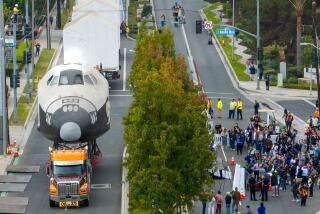Delivering the space shuttles is tougher than you think
WASHINGTON -- When you need to move a nearly 175,000-pound space shuttle with a 78-foot wingspan, who you gonna call?
NASA, of course. But also companies that own big cranes. In New York, call a barge owner. And in Los Angeles, traffic engineers and the LAPD.
Delivering retired orbiters to their final display sites in Los Angeles, New York, the Washington, D.C., area and Floridaâs Kennedy Space Center is presenting special challenges to the agency that put men on the moon.
Delivery crews have dusted off an apparatus last used in the 1980s for transporting the shuttle. They have rehearsed the delicate task of unloading the orbiter from atop a Boeing 747. And they have surveyed Los Angeles streets to ensure they can withstand the spacecraftâs weight.
The challenges will come into focus next week with the delivery of the first shuttle -- Discovery -- to its new home, the Smithsonianâs National Air and Space Museum annex in northern Virginia after a rare fly-over in the Washington area atop a modified Boeing 747.
Some 20 truckloads of equipment needed to unload the shuttle from the plane had to be hauled from Kennedy Space Center to Dulles International Airport. Two large cranes were brought in as well.
âTheyâve got X marks the spot out at Dulles so they know exactly where the cranes have to be situated,â Valerie Neal, space shuttle curator at the National Air and Space Museum, said in an interview.
NASA had to test equipment last used in 1985 when the Enterprise test shuttle was delivered to the Smithsonian.
âThere are some things that have been sitting in boxes since 1985,â Stephanie Stilson, who is overseeing the shuttle delivery for NASA, told the Los Angeles Times. She noted that crews staged a dry run testing the equipment âthree timesâ to ensure it would work.
Delivery of the shuttle Endeavour to Los Angeles in September or October presents more of a logistical challenge.
The orbiter, which has traveled about 123 million miles, will need to go another 12 miles or so through city streets from Los Angeles International Airport to the California Science Center in Exposition Park near downtown.
Designed to travel up to 17,500 mph in space, the shuttle is likely to poke along at 1 mph, as if it were on the Santa Monica Freeway.
Shuttles also will be delivered to New York -- via barge from John F. Kennedy International Airport to the Intrepid Sea, Air and Space Museum -- this summer and to the Kennedy Space Center visitor complex in Florida late this year or early next year.
Officials hope the deliveries will go smoother than the political turbulence encountered when NASA awarded the shuttles to cities other than Houston, home of mission control. At the time, a headline in the Houston Chronicle read, âOne Giant Snub for Houston.â
Splashy ceremonies are planned to welcome the shuttles.
After the 747 carrying Discovery flies over the Washington area, at about 1,500 feet, on Tuesday, the Smithsonian ceremony April 19 will feature Discovery crew members and space pioneer John Glenn, who returned to space in 1998 aboard the Discovery at age 77.
Los Angeles officials considered moving the shuttle at night to reduce traffic disruptions. But plans now call for moving the orbiter in the day, probably on a weekend, so the public can see it.
âNever before and never again will a space shuttle move through a major urban area,â Jeffrey N. Rudolph, the science centerâs president, said in an interview. âEven if we did it at midnight, people are going to come out in large numbers.â
A final route has yet to be selected.
The science center has already paid $14.2 million to NASA for preparation and delivery costs.
Los Angeles officials have secured the âoverland transporterâ used to ferry shuttles in the 1980s from their Palmdale assembly site to Edwards Air Force Base. Officials also are videotaping a proposed route to see what obstacles, such as traffic lights and utility poles, would need to be moved to accommodate the wide load.
Discovery will be exhibited at the National Air and Space Museumâs Steven F. Udvar-Hazy Center in Chantilly, Va., âin landing configurationâ with the crew cabin and payload bay door closed. Visitors wonât be able to venture inside Discovery, but Neal said they would be able to experience the interior through âvirtual reality kiosks.â
The California Science Center initially plans to display the shuttle horizontally but eventually will mount it vertically, as if for launch. The Kennedy Space Center plans to display Atlantis in âorbital configuration with payload bay doors open.â
ALSO:
Thanks to âHunger Games,â everythingâs dystopian
Springfield, Ore., revealed as âSimpsonsâ hometown. Sort of
Most wanted list: FBI replaces Bin Laden with alleged child pornographer
More to Read
Sign up for Essential California
The most important California stories and recommendations in your inbox every morning.
You may occasionally receive promotional content from the Los Angeles Times.











